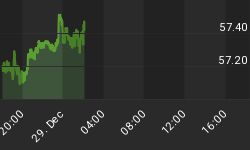Two weeks ago, the bond markets were indicating economic weakness, and rates headed lower. Last week, prior to Friday's jobs report, some new data showed a "stronger" economy, and rates had a bit of a bounce. On Friday, the economic recovery got a dose of reality as the jobs report was rather weak. Rates gapped lower at the market's open, and gold had an excellent day as it makes an assault on the $430 level.
Several weeks ago I suggested that precious metals were a buy because rates were headed lower (see report from mid-September). While I believe that even lower rates will be in our future, I think another dynamic is at work for the precious metals and that is, gold and all other hard assets are headed higher because the dollar is headed lower.
Economic expansion? The data doesn't support it.
Accommodative policy from the Federal Reserve? The bond market seems to suggest it.
Further devaluation of paper money? That's what the markets seem to be saying.
Figure 1/ Dollar Index/ daily
Figure 1 is a daily chart of the Dollar Index. Price is on the verge of definitively breaking through the double bottom support at 87.82. Also note the low volatility squeeze as indicated be the squeeze indicator in the bottom panel. (The squeeze indicator measures the distance between an upper and lower Bollinger Band and then compares that value to other values over the last 2 months; the current value is currently in the lowest 5% of values over the last months.) Low volatility usually begets high volatility and leads to a substantial move. As I have stated above, the dollar appears to be headed lower. Support is 86.29 and, a break below this level would be absolute confirmation that the bear market in the dollar continues.
But let's put some numbers to these observations, and look at a weekly chart of the dollar. See figure 2.
Figure2. Dollar Index/ weekly
As you can see, price has already broken below the up trend line (points AB), and the question I want to ask is: how reliable of a signal for lower prices in the dollar is a break below an up trend line? To answer that question I have constructed a trading system utilizing the Price Structure Analysis™ indicator. The Price Structure Analysis™ indicator allows me to construct trend lines by connecting pivot points, and then I can determine how price behaves above or below this trend line.
The premise of the system is to short the dollar when there is a break below an up trend line formed by two consecutive low pivot points (black dots). This is the situation with the price action in the dollar now. No stops were used, and positions were closed when the 5 bar moving average of price closed above the lower band of the trading/ thrust channel. The results are shown in table 1.
Table 1. Dollar Index Short trading system| Dollar Short System | |
| Index | Dollar |
| Time Period Studied | 17.9 years |
| % of Time in Market | 19% |
| # of Trades | 12 |
| % Profitable | 58.33% |
| Annual Rate of Return | 69% |
| Return on Account | 468% |
| Buy and Hold Return | -25.5% |
| Select Profit Factor | 4.93 |
| Average Win::Loss | 3.52 |
| Rina Index | 60 |
| Stop Loss | none |
| Greatest Loss | 3.1% |
| Consecutive Losers | 3 |
Of note, the biggest losing trade was a lost of 3.1%; the other 4 losing trades were closed for losses of less than 2%. The biggest draw down on an individual trade basis was at 7.66%; the remaining 11 trades experienced no greater than a 3% move against one's position.
Summary
Whether there has been an "all clear signal" on the economy continues to be a matter of debate. Rates and the dollar are headed lower, and commodities and hard assets should go higher.
That's The Technical Take!
Thanks for reading and I hope you have found my commentary insightful and profitable.
















